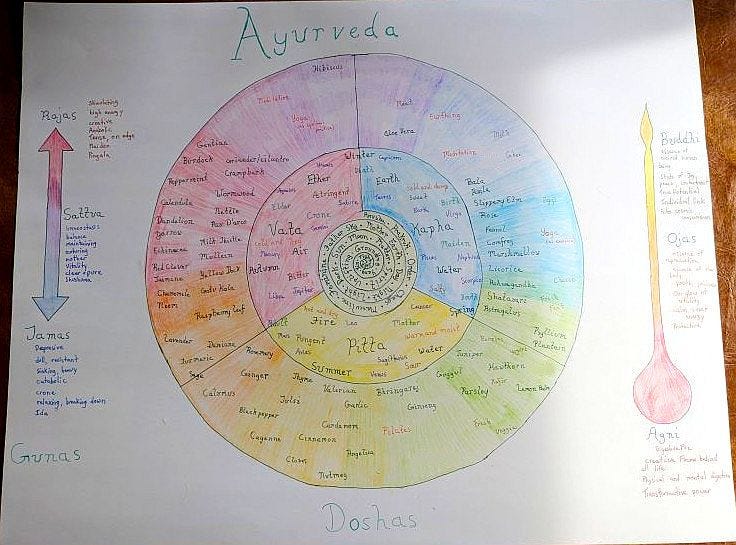Ayurveda Philosophy
A beginner's overview
This is really just a fun post to share with you, my readers, from my studies and assignments on Ayurvedic philosophy, systems and classifications. From Ayurveda philosophy there are several different systems or ideas, overlaying each other and adding depth to any classifications we try to use. I had a lot of fun creating this poster that attempts to depict that and I hope you will enjoy it as well, my teacher tells me I only have a couple of herbs in slightly the wrong place… so I think its good enough to share. :)
In the center, the beginning, is Consciousness and the Creative Force (Prakruti and Purusha) You need both. I added other terms to my spiral that also appear to be opposing forces and yet are dependent on one another for existence and creation. Light doesn’t exist without Dark, Chaos isn’t real if there isn’t also Order… All of our ancient cultures understand and respect these balancing forces in the world.
The next layer of Creation is the Elements: Earth, Water, Fire, Air and Ether. Ether in Ayurvedic philosophy is what we in the west might call Space, as in the space between the atoms that make matter. But in Ayurveda, this Space, or Ether isn’t seen as dead and empty, it is living consciousness itself.
Within the Elements, so many things can be “classified” but of course, nature doesn’t fit in a box, or even a circle, so this is up to interpretation and doesn’t always work perfectly. Ayurveda uses the Dosha system to classify the elements, the 6 tastes of Ayurvedic herbs, and the actions or effects these herbs have on our body:
Kapha: Earth and Water, Sweet and Salty, Cold and Wet, cooling and moistening effects.
Pitta: Water and Fire, Pungent and Sour, Hot and Damp to Hot and Dry, warming effects.
Vata: Air and Ether, Bitter and Astringent, Cold and Dry, cooling and drying effects.
There is SO MUCH more to the Dosha system than just categorizing herbs and foods, to try and go through all of it is beyond the scope of this post, I would have to write separate posts for each Dosha, and even then, it would only be an overview.
Then there are the Gunas. This is such an interesting part of Ayurveda and I will definitely do another post on the Gunas soon. But this concept of Balance, of reaching a Sattvic state of being, of understanding that for every Rajasic (high energy, exciting, adrenaline pulsing) event, there will be a Tamasic (low energy, depressive, exhausted) counterpart is so helpful when looking at an overview of life, and even for planning your days and events. I’ve seen it in parenting and in youth, and as we age we seem to become more Sattvic, more content with life being slight highs and lows instead of exhilarating highs and deep, depressive lows.
And finally I have the thermometer of Agni-Ojas-Buddhi. This concept is interesting and, as I described in a previous post, Agni is the very basis of health in Ayurveda. With strong and healthy Agni you will have good Ojas; youthfulness and vitality, which can then be channeled into Buddhi; higher consciousness, true potential and a state of joy, peace and contentment.
There you have it, a very basic and beginner’s overview of Ayurveda and its philosophy of life and health.



